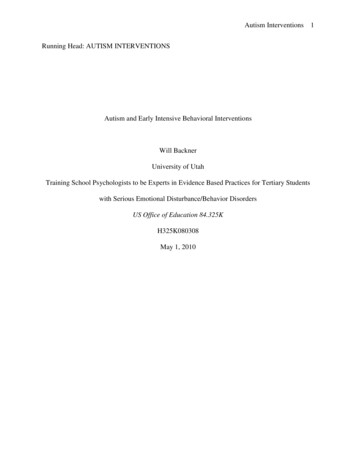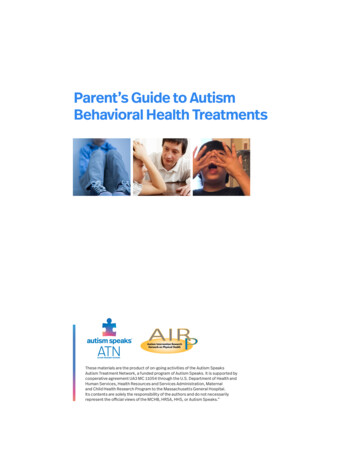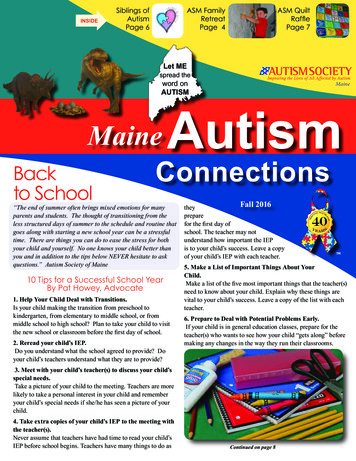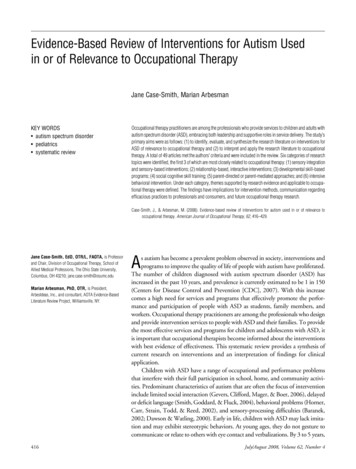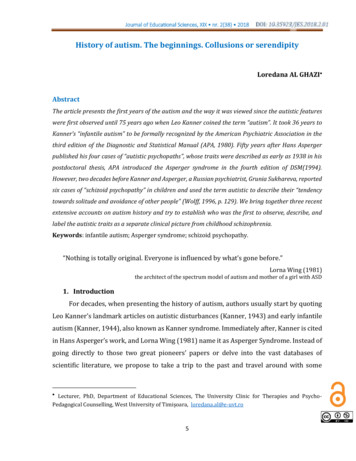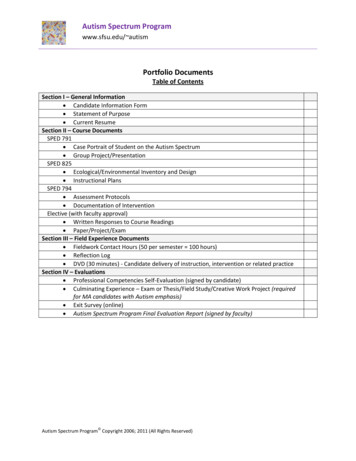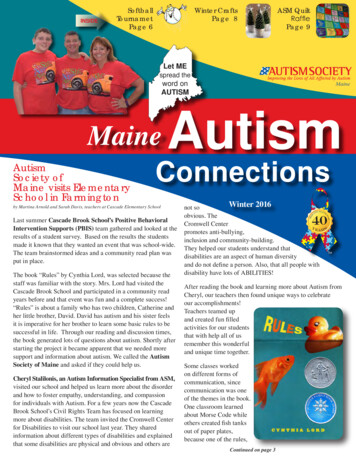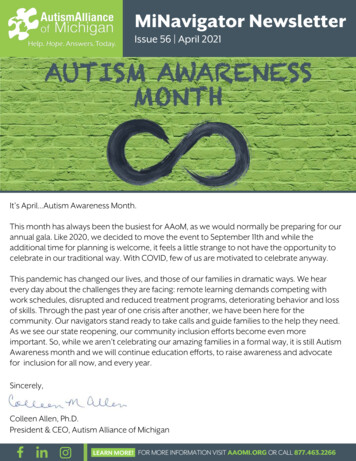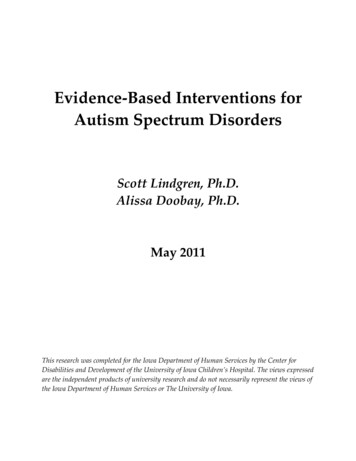
Transcription
Evidence-Based Interventions forAutism Spectrum DisordersScott Lindgren, Ph.D.Alissa Doobay, Ph.D.May 2011This research was completed for the Iowa Department of Human Services by the Center forDisabilities and Development of the University of Iowa Children’s Hospital. The views expressedare the independent products of university research and do not necessarily represent the views ofthe Iowa Department of Human Services or The University of Iowa.
TABLE OF CONTENTSPREFACE 3DEFINING AUTISM SPECTRUM DISORDERS (ASD) . 4ASSESSMENT OF AUTISM SPECTRUM DISORDERS . 6INTERVENTIONS FOR AUTISM SPECTRUM DISORDERS . 9Need for Evidence-Based Interventions 9Identifying Effective Interventions 9Basic Principles of Effective Early Intervention .10Research on ASD Interventions . 11Interventions Supported by Significant Scientific Evidence . 12Applied Behavior Analysis (ABA) . . 12Early Intensive Interventions . . 14Social Skills Training . 14Cognitive-Behavioral Therapy . . 15Medication . 15Other Evidence-Based Interventions . 16Interventions with Promising or Emerging Evidence . 17Interventions with Limited Scientific Evidence 17Interventions that are Not Recommended . . 20Using these Findings for Treatment Planning . 20SUMMARY OF EVIDENCE-BASED INTERVENTIONS FOR ASD . . 22REFERENCES 242
PREFACEAutism is a neurodevelopmental disorder that challenges families and professionalsto find effective interventions that can improve the lives of individuals with autismspectrum disorders. Due to the difficulty in finding interventions that work and thatare readily available regardless of geographic location or financial resources, the fieldhas nurtured many popular interventions that lack support from scientific research. Atthe same time, each child or adult with autism is unique, and some of the researchstrategies that have formed the foundation of traditional treatment research (such asrandomized controlled trials) have been difficult to complete with large samples ofparticipants with autism. For this reason, the interventions reviewed in this summarywere evaluated in relation to several accepted standards of scientific quality andincluded both randomized group studies and carefully controlled single-subjectresearch designs.This research was completed for the Iowa Department of Human Services by theCenter for Disabilities and Development of the University of Iowa Children’s Hospital.The views expressed in this summary are the independent products of universityresearch and do not necessarily represent the views of the Iowa Department of HumanServices or The University of Iowa. These findings have been updated regularly as newdata have been reported.About the Authors: Scott Lindgren, Ph.D., is Professor of Pediatrics in the Universityof Iowa Carver College of Medicine, and Alissa Doobay, Ph.D., is a Postdoctoral Fellowat the Belin-Blank International Center for Gifted Education and Talent Development atthe University of Iowa. Selected contributions to this research were provided during Dr.Doobay’s participation in the University of Iowa Leadership Education inNeurodevelopmental Disabilities (LEND) program at the Center for Disabilities andDevelopment.3
DEFINING AUTISM SPECTRUM DISORDERSAutism spectrum disorders (ASDs) are a group of neurodevelopmental disabilitiesdefined by significant impairments in social interaction, deficits in communication, andthe presence of rigid behaviors and restricted interests. The thinking and learningabilities of people with ASDs can vary – from gifted to severely limited. ASD typicallybegins before the age of 3 and can create challenges throughout a person's life. ASDoccurs in all racial, ethnic, and socioeconomic groups and is at least four times morelikely to occur in males than females.The primary ASDs are Autistic Disorder (or “autism”), Asperger’s Disorder, andPervasive Developmental Disorder - Not Otherwise Specified (PDD-NOS). Theseconditions share many of the same behaviors, but they differ in terms of when thebehaviors start, how severe they are, and the precise pattern of problems. Otherdisorders often listed as a PDD include Rett’s Disorder and Childhood DisintegrativeDisorder, although these disorders may no longer be included on the “spectrum” asnew diagnostic criteria for ASD are developed.Autistic DisorderAutistic Disorder or “autism” is defined by qualitative impairments in three areas offunction: (1) social interaction, (2) communication, and (3) restricted repetitive andstereotyped patterns of behavior, interests, and activities. Common symptoms includepoor eye contact, poor “reading” of social cues, failure to develop peer relationships,lack of social or emotional reciprocity, delayed speech development, difficultysustaining conversation, lack of make-believe play, repetitive motor mannerisms, andrigid adherence to routines. Symptoms are present before 3 years of age. As many as 6075% of children with Autistic Disorder also have intellectual disabilities, but somechildren with Autistic Disorder can develop average or even superior intellectualabilities. Even in children with intellectual disabilities, there may be isolated skills thatare highly developed (such as in music, math, or memory).Asperger’s DisorderAsperger’s Disorder or Asperger Syndrome is defined by impairments in socialinteraction combined with restricted or repetitive patterns of behavior, interests, andactivities. Common symptoms include poor “reading” of social cues, failure to developtypical peer relationships, lack of emotional reciprocity, intense interests orpreoccupations, and rigid adherence to routines. Children with Asperger Syndrome donot show general impairments in language or overall cognitive development, althoughimpairments in visual-motor skills and pragmatic (social) language are common.4
Pervasive Developmental Disorder - Not Otherwise Specified (PDD-NOS)The diagnosis of PDD-NOS is appropriate when there is severe and pervasiveimpairment in the development of reciprocal social interaction associated withimpairment in either verbal or nonverbal communication skills or with the presence ofstereotyped behavior, interests, and activities, but the criteria are not met for a morespecific disorder. This diagnosis is often used when a child shows several symptomsconsistent with an ASD, but does not meet the full criteria for either Autistic Disorder orAsperger’s Disorder.Other Pervasive Developmental DisordersThe essential feature of Childhood Disintegrative Disorder is a marked regression inmultiple areas of functioning following a period of at least 2 years of apparently normaldevelopment. After the first 2 years of life (but before age 10), the child shows aclinically significant loss of previously acquired skills in at least two of the followingareas: expressive or receptive language, social skills or adaptive behavior, bowel orbladder control, play, or motor skills. Rett’s Disorder or Rett Syndrome, which is agenetic disorder that occurs almost exclusively in girls, involves the development ofmultiple specific deficits following a period of normal early functioning. Between 5 and48 months of age, the child with Rett Syndrome shows a slowing of head growth, loss ofpreviously acquired purposeful hand skills, the development of stereotyped handmovements (e.g., hand wringing), a loss of social engagement, poorly coordinated gaitor trunk movements, and severely impaired language and psychomotor skills.Causes of AutismNo one knows for sure what causes autism, but scientists believe that both genesand the environment play a role. Research has shown that autism tends to run infamilies. Among identical twins, if one child has autism, then the other is likely to beaffected 75-90% of the time. Parents who have a child with an ASD have a 2-10% chanceof having a second child who is also affected. Some parents worry that vaccines causeautism, but the scientific evidence does not support this theory. There is some evidencethat exposure to factors in the environment (such as viruses or infections) may play arole in causing some forms of autism. It is important to recognize that autism is a brainbased disorder and is not caused by inadequate parenting; however, parents can playan important role in planning and carrying out interventions after an ASD is identified.PrevalenceIn 2009, the Centers for Disease Control and Prevention reported data on autismprevalence that concluded that the prevalence of autism had risen to 1 in every 110American children, with rates of 1 in every 70 boys and 1 in every 315 girls. In Iowa, as5
many as 6,500 children may have an ASD, although only a smaller number are formallydiagnosed and identified for services.Lifetime CostsThe Autism Society of America estimates that the lifetime cost of caring for a childwith an autism spectrum disorder ranges from 3.5 million to 5 million. Based on theseestimates, the United States is facing almost 90 billion annually in costs for autismspectrum disorders. These costs include research, insurance costs and non-coveredexpenses, Medicaid waivers for autism, educational spending, housing, transportation,employment, therapeutic services, and caregiver costs. Lifetime medical costs alone areroughly twice those of a typical American, and lost productivity and caregiving costsfor dependent adults with a severe ASD can exceed the costs of childhood care andtreatment.6
ASSESSMENT OF AUTISM SPECTRUM DISORDERSEarly identification is a key to early intervention, which has been shown to have asignificantly positive effect on long-term outcomes for children with ASD. Early signs ofautism are often noticed by 18 months of age, or even earlier. Some early signs or “redflags” that a child may have an ASD include the following:Lack of or delay in spoken languageRepetitive use of languageLittle or no eye contactLack of interest in other childrenLack of spontaneous or make-believe playPersistent fixation on parts of objectsPoor response to his/her nameFails to imitate caregiversMotor mannerisms (e.g., hand-flapping)Fails to point or show joint attentionAppropriate treatment of ASD should begin with a careful assessment to determinethe child’s specific strengths and needs. There are no specific medical tests fordiagnosing autism although there are genetic tests for some disorders that may beassociated with behaviors on the autism spectrum. An accurate diagnosis is based onsystematic interviewing, observation, and assessment of the child's communication,social interaction, behavior, and developmental level. In addition to assessing the keysymptoms of autism, a review of sleep, feeding, coordination problems, and sensorysensitivities is often recommended. Medical factors that may be causing pain orirritability should be recognized and treated whenever possible. Seizures are found in11-39% of individuals with ASD, and electroencephalography (EEG) should beconsidered if there is a concern about possible seizures. Although neuroimaging is notcurrently used routinely as part of diagnostic evaluation, an MRI can be conducted ifconcerns about identifiable neuropathology in brain structure are present. A metabolicworkup and genetic testing for syndromes with autism-like features (e.g., Fragile X,neurofibromatosis, tuberous sclerosis, velocardiofacial syndrome, 15q duplications, andAngelman syndrome) is often appropriate. Consultation with specialists may benecessary to assess for neurological (neurologist), genetic (clinical geneticist),gastrointestinal (gastroenterology), speech (speech/language pathologist), or motorconcerns (physical or occupational therapist).Several screening and assessment tools have been developed to specifically assessfor the presence of ASD in children and adolescents. Use of brief autism screeningchecklists such as the Modified Checklist for Autism in Toddlers (M-CHAT) at ages 187
24 months can be very helpful in early identification of an ASD by health care providersor early educators. Although ASD screenings may be completed by a number ofdifferent professionals (e.g., primary care physicians, speech pathologists, teachers,etc.), the diagnosis of ASD should typically be made by a psychologist, psychiatrist, ordevelopmental-behavioral pediatrician who has been trained in the diagnosis of ASD.Observation tools such as the Autism Diagnostic Observation Schedule (ADOS) andstructured diagnostic interviews such as the Autism Diagnostic Interview – Revised(ADI-R) are often used to provide additional rigor to the assessment of ASD.8
INTERVENTIONS FOR AUTISM SPECTRUM DISORDERSNeed for Evidenced-Based InterventionsIdentifying effective medical and behavioral treatments for neurodevelopmentaldisorders should be based on a solid foundation of scientific evidence. This tradition ofscientific investigation has long been a foundation of modern medicine, and the needfor identifying evidence-based treatments has received increasing recognition in thefield. In addition, as part of legislation under the No Child Left Behind Act (NCLB,2002), the field of education also requires the use of “effective interventions” to supportlearning. These interventions can only be validated through “scientifically basedresearch.” The call for the use of interventions that have proven their effectiveness isparticularly important for the ASD community, which has long been plagued by the useof unsupported and often controversial interventions. In fact, it has been suggested thatthe uncritical use of unproven “miracle” interventions has encouraged unrealistic,implausible, and unhealthy expectations about treatment results and have ultimatelyimpeded the progress of identifying effective interventions for children and adolescentswith ASD (Simpson, 2005).Identifying Effective InterventionsOne major barrier to the adoption of evidenced-based practices for ASD is the lackof consensus on how to identify and evaluate scientifically valid and effectiveinterventions. According to NCLB, “scientifically based research” is defined as“research that involves the application of rigorous, systematic, and objective proceduresto obtain reliable and valid knowledge” (NCLB, 2002). For a practice to be judged asscientific, it must meet particular standards, reliably yield positive results, and survive arigorous peer review process. In addition, scientifically based practices are validated bymeans of specific “gold standard” research designs that include random samples ofsubjects that are assigned to control and experimental groups or a series of replicationsof well-controlled studies using rigorous single-subject designs. However, the scientificmethod of validation has sometimes been criticized as being too narrow and as having anegative effect on ASD research because of the methodological restrictions that makethis type of research difficult to conduct in many real-life settings. The followingguidelines (Simpson, 2005) provide a balanced perspective for evaluating ASDinterventions:Just because a website or brochure lists an intervention as “evidence-based” or“research-based” does not make it true. It may take careful investigation todetermine whether a treatment truly has been validated.9
Rigorous methods of determining a treatment’s validity can take several formswhen conducted appropriately, including but not limited to single-subjectdesign, correlational studies, quasi-experimental design, and randomizedcontrolled trials.Information about a treatment’s effectiveness that comes from a single sourcethat is not supported by other research, lacks peer review, and comes primarilyfrom testimonials rather than empirical validation should be viewed withextreme caution.It is important to consider the match between the needs of the individual withASD and the focus of the intervention.It is important to consider the potential risks (e.g., cost, time commitment,adverse effects, impact on quality of life, etc.) of interventions.There is no single universally effective intervention for all children with ASD.The best programs often incorporate several research-based interventions andattend to the individual needs of children with ASD and their families.Basic Principles of Effective Early InterventionThe American Academy of Pediatrics (Meyer, Johnson, and the Council on Childrenwith Disabilities, 2007) has made a clear statement about the basic principles thatunderlie effective ASD interventions: “There is a growing consensus that importantprinciples and components of effective early childhood intervention for children withASDs include the following:Entry into intervention as soon as an ASD diagnosis is seriously consideredrather than deferring until a definitive diagnosis is made;Provision of intensive intervention, with active engagement of the child at least25 hours per week, 12 months per year, in systematically planned,developmentally appropriate educational activities designed to addressidentified objectives;Low student-to-teacher ratio to allow sufficient amounts of 1-on-1 time andsmall-group instruction to meet specific individualized goals;Inclusion of a family component (including parent training as indicated);Promotion of opportunities for interaction with typically developing peers to theextent that these opportunities are helpful in addressing specific educationalgoals;Ongoing measurement and documentation of the individual child’s progresstoward educational objectives, resulting in adjustments in programming whenindicated;Incorporation of a high degree of structure through elements such as predictableroutine, visual activity schedules, and clear physical boundaries to minimizedistractions;10
Implementation of strategies to apply learned skills to new environments andsituations (generalization) and to maintain functional use of these skills; andUse of assessment-based curricula that address:functional, spontaneous communication;social skills, including joint attention, imitation, reciprocal interaction,initiation, and self-management;functional adaptive skills that prepare the child for increasedresponsibility and independence;reduction of disruptive or maladaptive behavior by using empiricallysupported strategies, including functional assessment;cognitive skills, such as symbolic play and perspective taking; andtraditional readiness skills and academic skills as developmentallyindicated.”Research on ASD InterventionsIn this analysis of ASD interventions, the focus was on identifying treatments thatare based on strong scientific evidence. Medical, behavioral, cognitive, and educationalinterventions were reviewed. This analysis relied on data obtained from five primarysources of consensus judgments about ASD treatments: (1) the American Academy ofPediatrics (AAP) Council on Children with Disabilities, (2) the National Autism Center(NAC), (3) the Association for Science in Autism Treatment (ASAT), (4) the NationalProfessional Development Center (NPDC) on Autism Spectrum Disorders, and (5) thedetailed 2005 review of ASD interventions completed by Simpson and his colleagues.The NPDC review in particular establishes a balanced view of how to combine theresults of randomized, quasi-experimental, and single-subject studies to establish anevidence base for a particular type of treatment or for a specific intervention strategy.For the purposes of this analysis, we have categorized each type of ASD treatmentinto one of four categories based on the scientific evidence supporting the treatment:1. Significant scientific evidence if there is significant and convincing empiricalefficacy and support for the treatment.2. Promising or emerging scientific evidence if there is some scientific support forthe treatment having efficacy and utility with individuals with ASD, but theevidence is not yet convincing without further replication through qualityresearch.3. Limited scientific evidence refers to treatments that currently lack objective andconvincing supporting evidence and thus have undetermined utility andefficacy.11
4. Not recommended practices are those determined to lack efficacy and to bepotentially harmful based on available data.The following is a summary of the results of this analysis and a brief description ofeach type of intervention reviewed. When there was general consensus among the fivedata sources, classification decisions regarding specific interventions werestraightforward. Additional analysis and explanation were required when there werediffering conclusions among the five sources or when it was necessary to clarify theconditions under which a treatment could be confidently recommended for use. Wealso supplemented the conclusions reached by each data source when additional newfindings have clarified the conclusions for a particular type of treatment. The datasources often varied in how specific interventions were defined or labeled, as well as inthe content and scope of the scientific evidence that was reviewed to validate eachintervention. Despite these variations in approach, there was still substantial agreementamong the consensus sources.Interventions Supported by Significant Scientific EvidenceApplied Behavior Analysis (ABA)ABA is defined as the process of applying behavioral principles to change specificbehaviors and simultaneously evaluating the effectiveness of the intervention. ABAemphasizes both prevention and remediation of problem behavior. Significant attentionis given to the social and physical environment, including the antecedent conditionsand consequences that elicit and maintain behavior. Numerous empirical studies havedocumented the effectiveness of ABA with individuals with ASD. These interventionsshould typically be provided under the supervision of a trained behavioral psychologistor behavior analyst. Research suggests that the best outcomes occur when ABA isinitiated early in development, preferably prior to 5 years of age. There is an ongoingdebate about the amount of ABA needed in order for it to be optimally effective, withrecommendations typically ranging from 15 to 40 hours per week, depending onwhether ABA is being applied to comprehensive educational programming in theschools or to a targeted behavioral treatment program. Training caregivers to provideABA in the home or community settings is an important part of most ABA programs,and teleconsultation is proving to be a useful and effective strategy for providing ABAin rural or other underserved areas. In fact, ABA delivered through as little as 1 hourper week of parent training can be effective in reducing behavior problems andbuilding social communication in children with ASD. This intervention can be usedwith all ages and ability levels, and ABA principles are often included as part ofeffective early intensive intervention programs. The following specific ABAinterventions are described in greater detail (although this is not an exhaustive list):12
Discrete Trial Training (DTT) is grounded in behavioral learning theory andapplied behavior analysis, and it is sometimes referred to as “Lovaas therapy” inreference to Ivar Lovaas at UCLA, who was a strong early proponent of using DTT withchildren with autism. Using this intervention, a discriminative stimulus is presented,the child responds, and then the child receives a consequence (e.g., reward) based onthe response. DTT often incorporates the use of errorless learning, shaping, modeling,prompting, facing, correction, and reinforcement to encourage skill acquisition. It isespecially well-suited for skills that can be taught in small, repeated steps. Researchindicates that DTT can produce powerful behavioral outcomes in the areas of language,motor skills, imitation and play, emotional expression, academics, and the reduction ofself-stimulatory and aggressive behaviors. Special training is necessary to deliver DTTinterventions, and hiring a DTT trained therapist to provide 25-40 hours of therapy perweek can be expensive. This intervention can be used with all ages and ability levels.Functional Communication Training (FCT) is a behavioral methodology thatreplaces disruptive or inappropriate behavior with more appropriate and effectivecommunication. After the communicative “functions” of disruptive behaviors aredetermined through functional behavioral analysis, socially appropriate behaviors aretaught as replacements for problem behaviors. FCT has a strong research base,especially using single-subject research designs, and FCT has been shown tosignificantly reduce problem behavior and to increase communication and socialinteraction. This intervention is very effective with young children with limitedcognitive and language skills, but it can be used with individuals of all ages. Whendelivered through weekly training sessions with parents/caregivers and their children,FCT can be a very effective and efficient intervention strategy for reducing problembehavior and increasing communication and social behavior.Pivotal Response Training (PRT). The NPDC describes PRT as a systematicmethod for applying the scientific principles of ABA. PRT builds on a child’s initiativeand interests, which makes it particularly effective in developing communication, play,and social behaviors. This strategy enhances the pivotal learning variables ofmotivation, responding to multiple cues, self-management, and self-initiation, whichserves to influence target behaviors within a natural setting. Research has supported theeffectiveness of PRT in increasing motivation and improving language and play skills. Itis recommended that PRT be implemented by caregivers and teachers in naturalcontexts; it is considered cost- and time-efficient. This intervention can be used withpreschool-aged children through adults with mild cognitive impairments and withthose who have at least a minimal level of receptive and expressive language.13
Antecedent-Based Interventions. In applying ABA techniques, it is important notonly to provide reinforcement or punishment after a behavior has occurred, but also toset up antecedent conditions that increase the likelihood of success and reduce theprobability of problem behaviors occurring. Specific antecedent procedures that arefrequently used for ASD include choice, behavioral momentum, cueing and prompting,modifying task demands, errorless learning, priming, non-contingent reinforcement,and time delay. These types of interventions can be used with all ages and abilitylevels.Other Specific ABA Strategies. A wide range of specific ABA techniques havereceived significant empirical support, and comprehensive treatment programstypically make use of a “package” that includes several of these evidence-based ABAstrategies. Examples of these methods include prompting, time delay, reinforcement,extinction, task analysis, response interruption/redirection, and differentialreinforcement.Early Intensive InterventionsIntensive early intervention programs that provide ABA strategies, often incombination with developmental approaches, have been shown to produceimprovements in behavior, communication, and cognitive abilities. Lovaas-basedapproaches (as described above in the discussion of discrete trial training) are the mostwidely used and have the strongest research base thus far for programs of this type. Arandomized controlled trial of the Early Start Denver Model, which uses a combinedABA-developmental model, has also produced positive outcomes for young childrenwith ASD. A successful randomized trial for the Learning Experiences and AlternativeProgram for Preschoolers and Parents (LEAP) has been completed as well. Althoughthese studies are not without methodological limitations, the NAC review designatedcomprehensive behavioral treatment for young children using programs of this type asan “established treatment.”Social Skills TrainingDeficits in social interaction are core problems in ASD. There is good evidence thatinterventions to directly train social skills can be effective, and increasing prosocialbehaviors is typically a primary outcome in ABA interventions. Both the NCPC and theNAC standards also consider the use of social narratives/stories to be useful tools forsocial skills training. The use of peer-mediated interventions to build social skills iswell established as well. There is evidence that specific aspects of social interaction(e.g., eye contact, joint attention, verbal greetings, etc.) can be learned with focusedtraining. The NCPC analysis documents solid evidence for the effectiveness of social14
skills training groups, although the NAC standards consider a “social skills package” tobe an emerging rather than well-established practice.Cognitive-Behavioral TherapyThe scientific basis for the use of cognitive behavior therapy (CBT) with adolescentsand adults with mood or adjustment problems is extensive and diverse. In fact, CBT isone of the most widely used non-pharmacologic treatments for individuals with mentaland emotional disorders, especially depression, and its use with individuals withautism spectrum disorders is growing. CBT focuses on replacing negative or ineffectivepatterns of thought and behavior with structured strategies that are effective inimproving mood and adaptive functioning.In the autism research base, the scientific evidence for the effectiveness of "selfmanagement," a type of CBT, is described by the NPDC-ASD as follows: “Selfmanagement interventions help learners with ASD learn to independently regulatetheir own behaviors and act appropriately in a variety of home, school, and communitybased situations. With these interventions, learners with ASD are taught to discriminateb
Evidence-Based Interventions for Autism Spectrum Disorders Scott Lindgren, Ph.D. Alissa Doobay, Ph.D. May 2011 This research was completed for the Iowa Department of Human Services by the Center for
